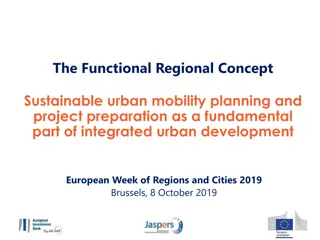Challenges and Opportunities in Mobility-as-a-Service: Policy Perspectives
Mobility-as-a-Service (MaaS) presents tailored end-to-end trip planning and payment services across transport modes. This transformative concept impacts pricing and business models, particularly in the urban context with a focus on accessibility, social issues, and efficient freight deliveries. The financial conundrum of MaaS involves charging criteria, externalities valuation, and the dilemma of financing. Explore the complexities of user payment, public sector regulation, and the financial equation for urban public transport.
Uploaded on Mar 16, 2025 | 0 Views
Download Presentation

Please find below an Image/Link to download the presentation.
The content on the website is provided AS IS for your information and personal use only. It may not be sold, licensed, or shared on other websites without obtaining consent from the author.If you encounter any issues during the download, it is possible that the publisher has removed the file from their server.
You are allowed to download the files provided on this website for personal or commercial use, subject to the condition that they are used lawfully. All files are the property of their respective owners.
The content on the website is provided AS IS for your information and personal use only. It may not be sold, licensed, or shared on other websites without obtaining consent from the author.
E N D
Presentation Transcript
Forest managment Forth Stage Lecture 2 Salahaddin University -Erbil College of Agricultural Engineering Sciences Forest Department 2023_2024 Ekhlass.hamad@su.edu.krd
Forest Inventory and Planning Processes Importance of Forest Inventory Forest inventory involves the systematic collection and analysis of data about forest resources. It provides essential information for effective forest management decision-making. Forest inventory helps in assessing the current condition of the forest, evaluating its productivity and growth potential, and identifying areas of concern or high conservation value.
Objectives of Forest Inventory Quantifying forest resources: Forest inventory aims to determine the composition, structure, and abundance of trees and other vegetation present in the forest. Estimating timber volume: It helps in estimating the amount of timber available for sustainable harvesting, providing valuable information for the forest industry. Assessing biodiversity: Forest inventory can identify and characterize habitats important for various species, contributing to biodiversity conservation efforts. Monitoring forest health: By tracking changes in forest condition over time, forest inventory helps identify potential issues such as disease outbreaks or invasive species infestations. Planning forest management activities: Inventory data guides the development of management plans, including silvicultural treatments, harvesting strategies, and restoration activities.
Forest Inventory Methods Forest inventory can be conducted using various methods, ranging from ground-based surveys to remote sensing technologies. Ground-based surveys involve field measurements of tree characteristics, such as diameter, height, age, and species. Remote sensing techniques, including aerial photography, satellite imagery, and LiDAR (Light Detection and Ranging), provide large-scale information on forest structure and composition.
Sampling Design in Forest Inventory Sampling design is crucial in forest inventory as it involves collecting data from a representative subset of the forest population. Random sampling techniques ensure unbiased and statistically valid results. Plot sampling involves measuring trees and vegetation within fixed plots, while transect sampling involves measurements along linear paths.
Forest Planning Forest planning is the process of setting goals and developing strategies to achieve them. It integrates the information obtained from forest inventory with social, economic, and ecological considerations. Forest planning considers multiple objectives, such as sustainable timber production, biodiversity conservation, recreation, and watershed protection.
Elements of Forest Management Plans Management goals and objectives: Forest management plans define specific objectives, such as the desired timber yield, conservation targets, or recreational opportunities. Silvicultural treatments: These are actions taken to manipulate the forest stand structure, including activities like thinning, pruning, and regeneration. Harvest scheduling: The plan outlines the timing, intensity, and methods of timber harvesting to ensure sustainable production and regeneration. Protected areas and buffer zones: Forest management plans designate areas for conservation, wildlife habitat, or protection of water resources. Monitoring and evaluation: The plan includes provisions for ongoing monitoring and evaluation of the implemented management practices to assess their effectiveness and make necessary adjustments.
Participatory Forest Planning Participatory forest planning involves involving stakeholders, including local communities, indigenous groups, government agencies, and NGOs, in the decision-making process. Engaging stakeholders ensures that multiple perspectives, values, and interests are considered, leading to more inclusive and sustainable forest management practices.
Case Study: Adaptive Forest Management Adaptive forest management is an approach that acknowledges the uncertainty and dynamic nature of forest ecosystems. It involves continuously learning from monitoring data, research, and stakeholder input to adjust management strategies and practices over time. Adaptive management allows for flexibility and the ability to address emerging challenges, such as climate change impacts.























